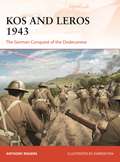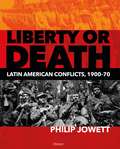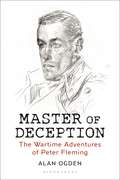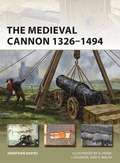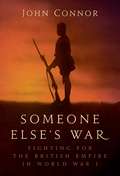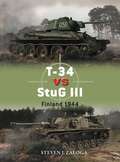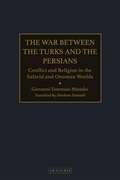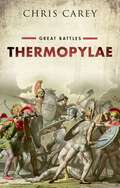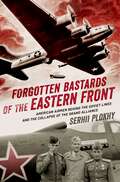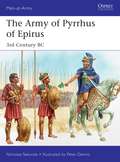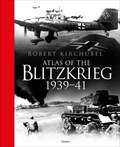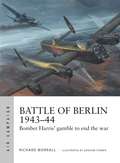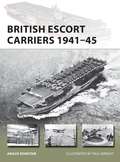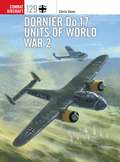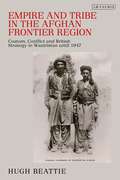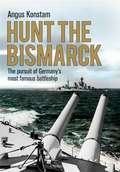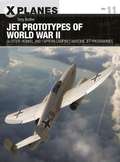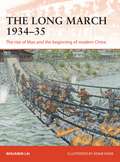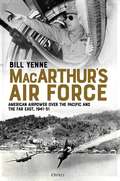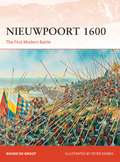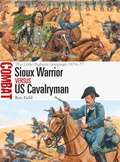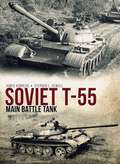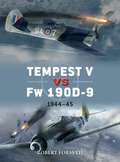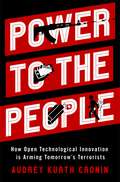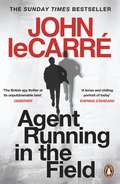- Table View
- List View
Kos and Leros 1943: The German Conquest of the Dodecanese (Campaign)
by Anthony RogersThis title is an illustrated account of the autumn 1943 battle for the Dodecanese, as Winston Churchill attempted to secure the Aegean islands in the wake of the Italian armistice. The occupation was a gamble intended to increase pressure against Germany and at the same time possibly provide encouragement for Turkey to join the Allies. Spearheaded by the Special Boat Squadron and the Long Range Desert Group, garrison troops were deployed to the Italian-occupied Dodecanese, but they were too late to prevent the Germans from taking control of the key island of Rhodes and its all-important airfields. An all-out German offensive followed. Air force and naval units supported a series of assaults by infantry and paratroopers, including specialist forces of the Division Brandenburg. Within three months, only Castelorizzo was still in British hands. Rhodes, Kos and Leros remained under German occupation until May 1945 and the end of the war in Europe. The Dodecanese would be Adolf Hitler's last enduring victory – and the last enduring British-led defeat.
Liberty or Death: Latin American Conflicts, 1900–70
by Philip JowettFrom the Banana Wars of the early 20th century through to the Football War of 1969, South and Central America has been a hotbed of revolutions, rebellions and conflicts as diverse as they are numerous. Some were small-scale affairs involving the poorly armed forces of Central American armies with rifles, machetes and a few aged machine guns. Others were full-scale conflicts involving sophisticated armies equipped with tanks, artillery and aircraft, and hundreds of thousands of troops. These wars often went largely unreported in the West, which was preoccupied with its own problems in fighting two world wars and dealing with Cold War tensions.Fully illustrated with a wealth of rare photographs, this fascinating story sheds light on seven decades of a continent in conflict that is rarely covered in English.
Master of Deception: The Wartime Adventures of Peter Fleming
by Alan OgdenMaster of Deception is a biography of Peter Fleming, elder brother of Ian Fleming, creator of James Bond. Peter Fleming worked as a travel writer and journalist, serving with distinction throughout World War II and played a crucial role in British intelligence operations in the Far East. This biography ranges from the personal life of Fleming such as his marriage to Celia Johnson, a famous actor of the time, to his extensive military intelligence career which took him from Norway and Greece to the Far East. Framed through the life of Peter Fleming this book offers an in-depth study of British intelligence operations in the Far East during World War II.
The Medieval Cannon 1326–1494: The Artillery That Transformed European Warfare (New Vanguard)
by Jonathan DaviesThe first illustration of a cannon in Europe can be dated quite precisely to 1326. This book explores the development of gunpowder, the earliest appearance of cast-bronze cannon in Western Europe, followed by the design and development of the wrought-iron cannon. The wrought-iron hoop-and-stave method of barrel construction was a system that came to dominate medieval artillery design both large and small until the end of the 15th century, and saw the cannon used not only as a prestige weapon, but start to be used as a practical and terrifying weapon on the medieval battlefield. In 1453, the Ottomans' conquest of Constantinople, with their extensive artillery, marked the triumph of medieval firepower. The book will focus on the technology and tactics of early European artillery on both sea and land, and assess its impact on medieval warfare.
Someone Else’s War: Fighting for the British Empire in World War I
by John ConnorWorld War I was the first truly global conflict and its effects were felt across the British Empire. When war broke out in 1914, Great Britain had the largest empire, encompassing one quarter of the population of the world. Many colonial citizens were to be enlisted into the war effort and shipped from their homes in Africa, Asia and Australasia to fight on the battlefields of the Western Front. What was the experience of war like for citizens of empire, whether combatants or not? How did the empire affect countries administered by Great Britain but geographically located tens of thousands of miles from the conflict? In this book, John Connor tells the story of the people whose lives were profoundly affected by 'someone else's war' – dragged, against their will, into a geopolitical conflict vastly removed from their normal lives.
T-34 vs StuG III: Finland 1944 (Duel)
by Steven J. ZalogaIn the summer of 1944, the Red Army staged a massive armoured assault up the Karelian Isthmus with the intent of eliminating any remaining German and Finnish forces facing the Leningrad region. Most of the Soviet units sent into Finland were new to the region, moving mainly from the fighting in the Leningrad area. As a result, some had the latest types of Soviet equipment including the new T-34-85 tank, fielded alongside the older T-34-76. Germany refused to sell the Finns new tanks without a reinforced military alliance, but in 1943 began selling them a few dozen StuG III assault guns. This made the StuG III battalion the most modern and powerful element of the Finnish armoured division, and it saw very extensive combat in the June–July summer battles. Featuring specially commissioned artwork and an array of archive photographs, this is the absorbing story of the parts played by Soviet and Finnish armour in the epic battles in Finland during June and July 1944.
The War Between the Turks and the Persians: Conflict and Religion in the Safavid and Ottoman Worlds
by Giovanni-Tommaso MinadoiThe Ottoman–Safavid conflict was viewed by the countries of Europe as being beneficial to their interests and there was therefore a subsequent hunger for up-to-date intelligence of events in that part of the world. As resident physician to the Venetian legation, Giovanni-Tommaso Minadoi he made use of his wide contacts within the community to gather this vital commercial and diplomatic intelligence. This book provides a detailed and lively account of the war between the Ottoman and Safavid dynasties in the late sixteenth century, when Ottoman sultan, Murad III, sought to extend his sphere of influence at the expense of the Safavids under Shah Mohammad Khodabandeh. There are very few western accounts of the conflict and Minadoi's is both highly informative and reliable and provides a valuable addition to non-western sources. Now rare, this edition is published with a new introduction from one of the foremost authorities on the history of Iran, Rudi Matthee.
Thermopylae: Great Battles (Great Battles)
by Chris CareyThe story of Thermopylae, the battle that helped define the identity of the ancient Greeks: how it was fought, how it has been remembered, and what it means for us today. During the Battle of Thermopylae in 480 BC, a Greek force of approximately 7,000 faced the biggest army ever seen in the Greek peninsula. For three days, the Persians—the greatest military force in the world—were stopped in their tracks by a vastly inferior force, before the bulk of the Greek army was forced to retreat with their rear guard wiped out in one of history's most famous last stands. In strict military terms it was a defeat for the Greeks. But like the British retreat from Dunkirk or the massacre at the Alamo, this David and Goliath story has taken on the aura of success. Thermopylae has acquired a glamour exceeding the other battles of the Persian Wars, passing from history into myth, and lost none of that appeal in the modern era. In Thermopylae, Chris Carey analyses the origins and course of this pivotal battle, as well as the challenges facing the historians who attempt to separate fact from myth and make sense of an event with an absence of hard evidence. Carey also considers Thermopylae's cultural legacy, from its absorbtion into Greek and Roman oratorical traditions, to its influence over modern literature, poetry, public monuments, and mainstream Hollywood movies. This new volume in the Great Battles series offers an innovative view of a battle whose legacy has overtaken its real life practical outcomes, but which showed that a seemingly unstoppable force could be resisted.
Forgotten Bastards of the Eastern Front: American Airmen behind the Soviet Lines and the Collapse of the Grand Alliance
by Serhii PlokhyThe full story of the first and only time American and Soviets fought side-by-side in World War II At the conference held in in Moscow in October 1943, American officials proposed to their Soviet allies a new operation in the effort to defeat Nazi Germany. The Normandy Invasion was already in the works; what American officials were suggesting until then was a second air front: the US Air Force would establish bases in Soviet-controlled territory, in order to "shuttle-bomb" the Germans from the Eastern front. For all that he had been pushing for the United States and Great Britain to do more to help the war effort--the Soviets were bearing by far the heaviest burden in terms of casualties--Stalin, recalling the presence of foreign troops during the Russian Revolution, balked at the suggestion of foreign soldiers on Soviet soil. His concern was that they would spy on his regime, and it would be difficult to get rid of them afterword. Eventually in early 1944, Stalin was persuaded to give in, and Operation Baseball and then Frantic were initiated. B-17 Flying Fortresses were flown from bases in Italy to the Poltava region in Ukraine. As Plokhy's book shows, what happened on these airbases mirrors the nature of the Grand Alliance itself. While both sides were fighting for the same goal, Germany's unconditional surrender, differences arose that no common purpose could overcome. Soviet secret policeman watched over the operations, shadowing every move, and eventually trying to prevent fraternization between American servicemen and local women. A catastrophic air raid by the Germans revealed the limitations of Soviet air defenses. Relations soured and the operations went south. Indeed, the story of the American bases foreshadowed the eventual collapse of the Grand Alliance and the start of the Cold War. Using previously inaccessible archives, Forgotten Bastards offers a bottom-up history of the Grand Alliance, showing how it first began to fray on the airfields of World War II.
The Army of Pyrrhus of Epirus: 3rd Century BC (Men-at-Arms)
by Nicholas SekundaPyrrhus was one of the most tireless and famous warriors of the Hellenistic Age that followed the dispersal of Alexander the Great's brief empire. After inheriting the throne as a boy, and a period of exile, he began a career of alliances and expansion, in particular against the region's rising power: Rome. Gathering both Greek and Italian allies into a very large army (which included war-elephants), he crossed to Italy in 280 BC, but lost most of his force in a series of costly victories at Heraclea and Asculum, as well as a storm at sea. After a campaign in Sicily against the Carthaginians, he was defeated by the Romans at Beneventum and was forced to withdraw. Undeterred, he fought wars in Macedonia and Greece, the last of which cost him his life. Fully illustrated with detailed colour plates, this is the story of one of the most renowned warrior-kings of the post-Alexandrian age, whose costly encounters with Republican Rome have become a byword for victory won at unsustainable cost.
Atlas of the Blitzkrieg: 1939–41
by Robert KirchubelIn September 1939, Nazi Germany launched its infamous Blitzkrieg invasion of Poland, bringing about the outbreak of World War II. Faced with highly tactical and accelerated attacks aimed at disrupting the line of defence and encircling vulnerable troops, Allied forces broke under pressure. Within the space of a year, France had been invaded and occupied, while the forces of Great Britain had retreated headlong back across the Channel. Further campaigns in the air and at sea sought to subdue the British Isles, while more lightning-fast attacks in 1941 overran Yugoslavia and Greece, leaving the bulk of Continental Europe under Nazi control. Though the dominance of the Blitzkrieg method was to be challenged in the latter part of the war, as Allied forces found methods of disrupting the attacks and dominating the battlefields, its unparalleled success in the early years of the conflict brought Europe to its knees. Featuring 107 detailed maps, this impressive atlas shows, in intricate detail, the fighting and physical challenges faced by the German attackers and Allied defenders. This will be a treasure for World War II enthusiasts and collectors alike.
Battle of Berlin 1943–44: Bomber Harris' gamble to end the war (Air Campaign)
by Richard WorrallThroughout late-1943 into early-1944, an epic struggle raged over the skies of Germany between RAF Bomber Command and the Luftwaffe. This campaign had been undertaken by the Commander-in-Chief Bomber Command, Air Chief Marshal Sir Arthur Harris, and was baptized 'The Battle of Berlin'. The Berlin campaign was a hard, desperate slog. Struggling against dreadful and bitter winter weather, Bomber Command 'went' to Berlin a total of sixteen times, suffering increasingly severe losses throughout the winter of 1943/44 in the face of a revitalized German air-defence. The campaign remains controversial and the jury, even today, is ultimately undecided as to what it realistically achieved. Illustrated throughout with full-colour artwork depicting the enormous scale of the campaign, this is the story of the RAF's much debated attempt to win the war through bombing alone.
British Escort Carriers 1941–45 (New Vanguard)
by Angus KonstamIn 1941, as the Battle of the Atlantic raged and ship losses mounted, the British Admiralty desperately tried to find ways to defeat the U-Boat threat to Britain's maritime lifeline. Facing a shortage of traditional aircraft carriers and shore-based aircraft, the Royal Navy, as a stopgap measure, converted merchant ships into small 'escort carriers'. These were later joined by a growing number of American-built escort carriers, sent as part of the Lend-Lease agreement. The typical Escort Carrier was small, slow and vulnerable, but it could carry about 18 aircraft, which gave the convoys a real chance to detect and sink dangerous U-Boats. Collectively, their contribution to an Allied victory was immense, particularly in the long and gruelling campaigns fought in the Atlantic and Arctic. Illustrated throughout with detailed full-colour artwork and contemporary photographs, this fascinating study explores in detail how these adaptable ships had such an enormous impact on the outcome of World War II's European Theatre.
Dornier Do 17 Units of World War 2 (Combat Aircraft)
by Chris GossInitially designed as a high-speed mail aeroplane and airliner, the Do 17 first made an appearance as a military aircraft in the Spanish Civil War, both as a bomber and in reconnaissance roles. In the early stages of World War II, it, together with the Heinkel He 111, formed the backbone of the German bomber arm over Poland, France, Belgium and the Low Countries, and saw action in almost every major campaign in this period. However, by the start of the Battle of Britain, the Do 17's limited range and small bomb load meant that it was ripe for replacement by the Ju 88. Though it performed well at lower altitudes, the model suffered heavy losses during raids, particularly during the Blitz and were increasingly phased out. This fully illustrated study uses detailed full-colour artwork and authoritative text from an expert author to tell the full operation story of one of Nazi Germany's best light bombers from the early years of World War II.
Empire and Tribe in the Afghan Frontier Region: Custom, Conflict and British Strategy in Waziristan until 1947
by Hugh BeattieWaziristan, a region on the border between Afghanistan and Pakistan, has in recent years become a flash point in the so-called 'War on Terror'. Hugh Beattie looks at the history of this region, examining British attempts to manage the tribes from 1849 until Pakistan's declaration of independence in 1947. He explores British attempts to divide the frontier region into separate British and Afghan spheres of influence. In the minds of British policymakers, this demarcation would secure the position of the Empire, and so Beattie highlights the various policy initiatives towards the frontier region over the period in question. Crucially, he analyses how the British perceived the local tribes, what constituted authority within tribal frameworks, and the military and political ramifications of these perceptions. As he also explores the contemporary relevance of this region, taking into account the resurgence of the Taliban in Waziristan, Beattie's analysis is vital for those interested in the history and security implications of the Afghan frontier with Pakistan.
Hunt the Bismarck: The pursuit of Germany's most famous battleship
by Angus KonstamHunt the Bismarck tells the story of Operation Rheinübung, the Atlantic sortie of the Nazi Germany's largest battleship in May 1941. Bismarck entered service in the summer of 1940. She was well-armed, with eight 15-inch guns as well as a powerful array of lighter weapons, while her armoured protection earned her the reputation of being unsinkable. This claim was finally put to the test in May 1941, when she sortied into the Atlantic and fought the legendary battle of the Denmark Strait, destroying HMS Hood, the pride of the Royal Navy. Bismarck was now loose in the North Atlantic. However, damage sustained in the battle limited her ability to roam at will, while the Royal Navy deployed the Home Fleet to revenge the Hood. The stage was set for the greatest chase story in the history of naval warfare. Drawing on a wealth of first-hand accounts, and intertwining extensive research into a fast-paced narrative, this is the most readable and accurate account of Bismarck's epic voyage ever produced.
Jet Prototypes of World War II: Gloster, Heinkel, and Caproni Campini's wartime jet programmes (X-Planes)
by Tony ButtlerWhile World War II raged, pioneering aircraft and engine designers were busy developing the world's first practical jet-powered research aircraft to test and prove the new technology. This book examines the aircraft that paved the way for Germany's Me 262 and Britain's Meteor - the world's first jet fighters. Throughout the war, Germany, Italy and Britain engaged in top-secret jet programmes as they raced to develop the airpower of the future. Various experimental aircraft were trialled in order to achieve the goal of producing an effective engine and fighter that could harness the potential of the jet power. These included the German Heinkel He 178 research aircraft and Heinkel He 280 jet fighter prototype, the famed British E.28/39 research aircraft built by Gloster Aircraft as well as the stillborn E.5/42 fighter and E.1/44 Ace fighter prototype, and finally the remarkable Italian Caproni-Campini N.1/CC 2 research aircraft.Illustrated throughout with full-colour artwork and rare photographs, this fascinating study examines the fore-runners to the military jet age.
The Long March 1934–35: The rise of Mao and the beginning of modern China (Campaign)
by Benjamin LaiEvery nation has its founding myth, and for modern China it is the Long March. In the autumn of 1934, the Chinese Nationalists under Chiang Kai-shek routed the Chinese Communists and some 80,000 men, women and children left their homes to walk with Mao Zedong into the unknown. Mao's force had to endure starvation, harsh climates, and challenging terrain whilst under constant aerial bombardment and threatened by daily skirmishes. The Long March survivors had to cross 24 rivers and 18 mountain ranges, through freezing snow and disease-ridden wilderness to reach their safe-haven of Yan'an. In military terms, the Long March was the longest continuous march in the history of warfare and it came as a terrible cost – after one year, 6,000 miles and countless battles, fewer than 4,000 of the original marchers were left. Illustrated with stunning full-colour artwork, this enthralling book tells the full story this epic display of resilience, and shows how, from the desert plateau of Yan'an, these survivors would grow the army that conquered China 14 years on, changing history forever.
MacArthur’s Air Force: American Airpower over the Pacific and the Far East, 1941–51
by Bill YenneGeneral Douglas MacArthur is one of the towering figures of World War II, and indeed of the twentieth century, but his leadership of the second largest air force in the USAAF is often overlooked. When World War II ended, the three numbered air forces (the Fifth, Thirteenth and Seventh) under his command possessed 4,004 combat aircraft, 433 reconnaissance aircraft and 922 transports. After being humbled by the Japanese in the Philippines in 1942, MacArthur and his air chief General George Kenney rebuilt the US aerial presence in the Pacific, helping Allied naval and ground forces to push back the Japanese Air Force, re-take the Philippines, and carry the war north towards the Home Islands. Following the end of World War II MacArthur was the highest military and political authority in Japan, and at the outbreak of the Korean War in June 1950 he was named as Commander in Chief, United Nations Command. In the ten months of his command his Far East Air Forces increased dramatically and saw the first aerial combat between jet fighters. Written by award-winning aviation historian Bill Yenne, this engrossing book traces the journey of American air forces in the Pacific under General MacArthur's command, from their lowly beginnings to their eventual triumph over Imperial Japan, followed by their entry into the jet age in the skies over Korea.
Nieuwpoort 1600: The First Modern Battle (Campaign)
by Bouko de GrootThe Eighty Years' War began as a limited Dutch rebellion seeking only religious tolerance from their Spanish overlords, but it quickly escalated into one of the longest wars in European history. Spain's failed invasion of 1599 and the mutinies that followed convinced Dutch leaders that they now should go on the offensive. This campaign pitted two famous leaders' sons against each other: Maurice of Nassau and Archduke Albert VII. One led an unproven new model army, the other Spain's 'unbeatable' Tercios, each around 11,000-men strong. The Dutch wanted to land near Nieuwpoort, take it and then march on to Dunkirk, northern home port of the Spanish fleet, but they were cut off by the resurgent and reunited Spanish army. The two forces then met on the beach and in the dunes north of Nieuwpoort. This book uses specially commissioned artwork to reveal one of the greatest battles of the Eighty Years' War – one whose influence on military theory and practice ever since has been highly significant.
Sioux Warrior vs US Cavalryman: The Little Bighorn campaign 1876–77 (Combat)
by Ron FieldFollowing the discovery of gold deposits, in December 1875 the US Government ordered the indigenous population of the Black Hills in what is now South Dakota and Wyoming, the Sioux, to return to the Great Sioux Reservation. When the Sioux refused, the US Army sent forces into the area, sparking a conflict that would make Lieutenant Colonel George Custer, Chief Sitting Bull, Crazy Horse, and others household names around the world. Examining a series of engagements in the Black Hills War, including Rosebud, Little Bighorn, and Slim Buttes, this fully illustrated study assesses the forces fighting on both sides in this momentous campaign, casting light on the origins, tactics, armament, and battlefield performance of the US Cavalry and their Sioux opponents at the height of the Indian Wars.
Soviet T-55 Main Battle Tank
by James Kinnear Stephen SewellThe T-55 is one of the most iconic weapons created by the Soviets during the Cold War and also one of the most widely deployed weapons in history. Like its younger brother, the T-54, the T-55 enjoyed a long career in the Red Army and even into the early days of the reformed Russian Army. Under their control it saw very little combat use or deployments, but it was widely sold to other nations and participated in many of the wars and combat operations from the mid-1960s to the present. The T-55 has been employed in almost every conflict in the Middle East and Africa from its introduction into service. Even today the tank is still employed by both sides in the Syrian Civil War, and they are also in service with Kurdish forces in the struggle against ISIS in the northern part of Iraq.Containing more than 400 stunning contemporary and modern photographs, and written by two experts on Soviet armour, this authoritative book tells the complete story of the T-55, one of the most widely produced tanks of all time.
Tempest V vs Fw 190D-9: 1944–45 (Duel)
by Robert ForsythArguably two of the finest piston-engined fighters ever built, the Tempest V and Fw 190D-9 raised the bar in terms of aircraft design and operational capability during World War II. The long-nosed 'Dora 9', designed by Kurt Tank, first appeared in the skies over the Western and Eastern Fronts in the late summer of 1944. Fast, and with an exceptional rate of climb, it quickly bettered almost every fighter that the RAF, USAAF and Soviet Red Air Force could field. The Hawker Tempest V entered service in early 1944, initially proving itself a stalwart performer when it was deployed to intercept V1 flying bombs over southern England. From the autumn of 1944, the Tempest V also equipped squadrons of the 2nd Tactical Air Force, operating in support of the Allied armies advancing across north-west Europe. It became a potent ground-attack aircraft, armed with underwing rockets, but also a first-class interceptor when pitted against the Luftwaffe's advanced Fw 190D-9 and Me 262.Featuring full colour artwork, this book describes in fascinating detail combats between the Tempest Vs of No 274 Sqn and the Fw 190D-9s of I. and III./JG 26 between February and April 1945.
Power to the People: How Open Technological Innovation is Arming Tomorrow's Terrorists
by Audrey Kurth CroninEssential reading on how technology empowers rogue actors and how society can adapt. Never have so many possessed the means to be so lethal. A dramatic shift from 20th century "closed" military innovation to "open" innovation driven by commercial processes is underway. The diffusion of modern technology--robotics, cyber weapons, 3-D printing, synthetic biology, autonomous systems, and artificial intelligence--to ordinary people has given them access to weapons of mass violence previously monopolized by the state. As Audrey Kurth Cronin explains in Power to the People, what we are seeing now is the continuation of an age-old trend. Over the centuries, from the invention of dynamite to the release of the AK-47, many of the most surprising developments in warfare have occurred because of technological advances combined with changes in who can use them. That shifting social context illuminates our current situation, in which new "open" technologies are reshaping the future of war. Cronin explains why certain lethal technologies spread, which ones to focus on, and how individuals and private groups will adapt lethal off-the-shelf technologies for malevolent ends. Now in paperback with a foreword by Lawrence Freedman and a new epilogue, Power to the People focuses on how to both preserve the promise of emerging technologies and reduce risks. Power is flowing to the people, but the same digital technologies that empower can imperil global security--unless we act strategically.
Agent Running in the Field: A BBC 2 Between the Covers Book Club Pick
by John le CarréPre-order John le Carré's new novel Agent Running in the Field now, and be one of the first to read it.'No other writer has charted - pitilessly for politicians but thrillingly for readers - the public and secret histories of his times' Guardian________________________________Nat, a 47 year-old veteran of Britain's Secret Intelligence Service, believes his years as an agent runner are over. He is back in London with his wife, the long-suffering Prue. But with the growing threat from Moscow Centre, the office has one more job for him. Nat is to take over The Haven, a defunct substation of London General with a rag-tag band of spies. The only bright light on the team is young Florence, who has her eye on Russia Department and a Ukrainian oligarch with a finger in the Russia pie. Nat is not only a spy, he is a passionate badminton player. His regular Monday evening opponent is half his age: the introspective and solitary Ed. Ed hates Brexit, hates Trump and hates his job at some soulless media agency. And it is Ed, of all unlikely people, who will take Prue, Florence and Nat himself down the path of political anger that will ensnare them all. Agent Running in the Field is a chilling portrait of our time, now heartbreaking, now darkly humorous, told to us with unflagging tension by the greatest chronicler of our age._______________________________'John le Carré is as recognisable a writer as Dickens or Austen' Financial Times'No writer has ever been better at turning the act of two people talking politely to each other across a desk into a blood sport' Telegraph
